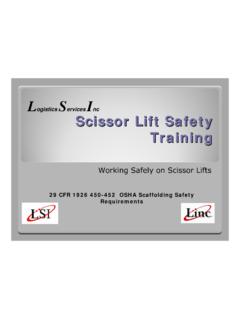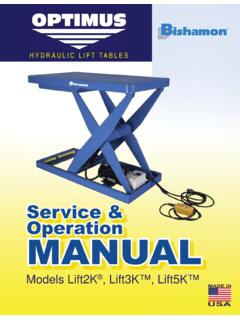Transcription of AerialLifts - Occupational Safety and Health Administration
1 RetrainingWorkers should be retr aine d if any of the foll owi ngconditionsoccur: An accidentoccursduringae ria l lift use, Wor kpla ce ha zar ds inv olv ing an aeri al li ft aredi scovered, or A di ffere nt ty pe of ae rial lift is use oye rs are al so required to re tra in wor ker swho theyobserve oper ati ng an ae ria l liftimproperly .Wh at to Do Bef ore Oper atin g anAeri al Li ftPre-start Inspect ionPrior to each wor k shi ft, conducta pr e-startinspecti on to ver ify that the equipment and al lits components ar e in sa fe operating ow the manufacturer s re commendati onsand includea che ck of:Vehiclecomponents Proper fl uid lev el s (oil , hydrauli c, fue l andcool ant); Le aks of flui ds; Wheels and ti res; Ba tteryand char ger ; Lower-le vel control s; Horn,gauges, lightsand backupala rms; Ste eri ng and bra Ope rati ng and eme rge ncy controls; Per sonalprotecti ve de vi ce s; Hydr auli c, air , pneumatic, fue l and electr ica lsy stems; Fi berglass and othe r insulating components.
2 Missing or unr eada bl e pl aca rds, war ni ngs, orope rati onal , instructionaland controlmar ki ngs; Mechanicalfa steners and locki ng pi ns; Ca ble and wiri ng ha rnesses; Outr iggers, stabi lize rs and othe r str uctures; Looseor missing par ts; Gua rdra il not ope rate any aeria l lift if any of thesecomponents are defe ctiveunti l it is re pai red by aqua li fie d pe rson. Remov e de fecti ve aeri al liftsfrom se rvi ce (tag out) untilre pai rs are ionsEmpl oye rs mustassure tha t wor k zone s areinspecte d for haza rds and ta ke cor re ctiveacti onsto el iminate suchhaza rds beforeand duri ng ope r-ationof an ae ri al lift. Itemsto look for include:An ae rial lift is any vehicle-mounteddeviceusedto elevat e personnel, including: Ext end able boom platforms, Aeri al la dders, Arti cul atin g (joi nt ed) boomplatforms, Ve rti cal tow ers, and Any comb ina ti on of the ial lift s have replacedladdersand scaf foldingon many jo b sit es due to theirmobilityandfl exi bili ty.
3 They maybe madeof metal,fiberglass-rei nf orc ed plast ic, or othermaterials. Theymaybe po we red or manuallyop erated,and arecons ider ed to be aerialli fts wh etheror not theycan rota te around a primarilyvert ical y workersare injuredor killedon aerialliftseac h A provides th e following inf ormationto hel pemp lo yers and wo rkersrecognizeand avoidsaf et y hazardsth ey mayencounterwhentheyuseaer ial lift rds As socia te d with Ae rial Lif tsTh e fol lowin g hazards,amongot hers,ca n lead tope rso nal inju ry or death: Fall fro m el ev ate d level , Obj ects fall in g from lifts, Tip- ov ers, Eje ctio ns from th e lift platform, Str uctu ral fai lure s (collapses), Ele ctri c sho ck (electrocutions), Ent ang leme nt ha za rds, Con tac t wi th ob jects,an d Con tac t wi th cei li ngs and otheroverheadob jec ni ngOnl y trai ned an d authorizedpersonsare allowedto oper ate an aerial lift.
4 Trainingshouldinclude: Exp lana tion s of electrical,fall, and fal lin g obj ectha zard s; Pro cedu res fo r dealingwithhazards; Reco gni zing and avoidingunsafeco ndi tionsinth e work set tin g; Ins truc tio ns for correctoperationof the li ft(i ncl udi ng max imumintendedloadand loa dca paci ty); Demo nst rati on s of the skillsand kn ow ledgene ede d to opera te an aeriallift beforeope rati ngit on th e jo b; Whe n an d how to performinspections ; and Manu fa ct ure r s Dr op- off s, ho le s, or unstablesurfaces suchaslo os e di rt; In ade quat e ce il in g hei ghts; Sl ope s, dit ch es, or bumps; De bris and fl oor obstructions; Overhe ad el ect ri c powerlinesand communica -ti on ca bles; Ot her overhead obstructions; Ot her haza rdo us locationsand atmo spheres; Hi gh wind and ot her severewe atherco ndi ti ons,su ch as ice; an d Th e presen ce of othersin closeprox imity to thewor at to Do Wh il e Ope rat ing anAer ial LiftFa ll Pro tection: En sur e th at accessgatesor openingsar e cl ose d.
5 St and fi rmly on the fl oor of the bucket or liftpl at for m. Do no t climbon or lean overguardrails orha nd rai ls. Do no t use pla nks , ladd ers, or otherdevi ces as awor king po si ti on . Us e a body harnessor a restrainingbelt wi th ala ny ard at tach ed to the boomor bucket. Do no t belt- off to adjacentstructuresor pole swhi le in th e on/Tr aveling/Loading: Do no t excee d the load -capacity lim it s. Taketheco mb ined we igh t of the worker(s), tools andmat erialsinto acco un t whe n ca lc ula ti ng the load. Do no t use the aeriallift as a crane. Do no t carry obj ec ts largerthanthe pla tfor m. Do no t drive wi th the lift platformraise d (unlessthe manu fa ct ure r s instructionsallowthi s).
6 Do no t opera te lo wer levelco ntrolsunle sspe rm issio n is ob tainedfromthe worker(s)in theli ft (e xcept in emergencies). Do no t excee d ver tical or horizontalrea ch li mits. Do no t opera te an aeriallift in highwinds abovetho se recom men ded by the manufacturer. Do no t overri de hydraulic,mechanical, orel ect rica l saf ety rh ea d Pr otection: Be awa re of overheadclearanceand ov er headobj ects , incl ud in g ceilings. Do not positionae ria l lifts between ov er he adha zardsif possible. Trea t all ove rhea d power line s and communica-ti on cabl es as ener gized,and sta y at least 10 fee t(3 meters) away. Ensurethat the powerutil ity or powerli newor kers de-e nergize power li nes in the vici ni tyof the wor bilityinthe Work Zone: Se t outri gge rs on pa ds or on a leve l, sol idsur face.
7 Se t bra kes whenoutr igge rs are use d. Use wheel chockson sl opedsurfaces whe n it issa fe to do so. Se t up wor k zonewar nings,suchas cone s andsi gns, whe n ne ce ssar y to war n othe aer ial lifts offe r protection fr om el ectri cshockand electr ocution by isol atingyou fr omele ctrical , an insulate d aer ia l liftdoe s not pr otectyou if the re is another pa th togr ound(for insta nce, if you touchanother wi re ).To mai ntai n the effective nessof the insul atingde vi ce, do not dri ll hole s in the dar ds that Appl yOSHAS tandards:29 CFR 191 7, 29 CF R 1910. 269 (p), 29 CF R192 1, 29 CFR 19 26. 45 3, 29 CF R 192 6. 502 .AmericanNational StandardsInstit utesst andards:AN SI /SI A A9 -19 69, AN SI/ SI A A92.
8 3 ,AN SI /SI A A9 , AN SI/S IA A9 2. iti onal Info rmationOS HA ha s a var iety of publ ica tions , st andard s,tec hni ca l assista nce and compliance toolsto hel pyou . OSHA also offe rs exte nsi ve assist ance thro ughwor kpl ace consulta ti ons, grant s, strat eg icpar tn er sh ip s, sta te pla ns , tr aini ng and educ at io HA s Sa fe ty and He alth Pr ogr am ManagementGui de lines (5 4 Fede ral Regi ste r 39 04-3916,Januar y26 , 1989) de ta il eleme nts cr iti ca l to the dev elopmentof a su cce ssfu l sa fe ty and he alth pr fi le a complaint by phone, repo rt an em er gency,or ge t OS HA advice, assistance, or products,contact your nea rest OSHA office or ca ll us toll-freeat 1-800- 32 1- OSHA(6 74 2).Thi s is oneina seriesofinformati onalfa ctsheet s highlightingOSHApr ograms, doesnot imposean y newcompliancerequirements.
9 Fora co mprehensiveli st of co mpliancerequirements ofOSHA standards orregulations,refertoTitl e 29of theCodeof informationwill bemadeavailable to sensory-impairedindividualsupon (2 02)69 3-1999;thete le ty pewriter(TTY)numberis (8 77) al Safetyand ov 1- 80 0-3 21 -6 74 2Fo r assist ance, canhelp. It s confidential .DSG4/2 01 1
















